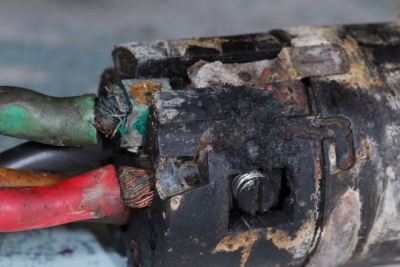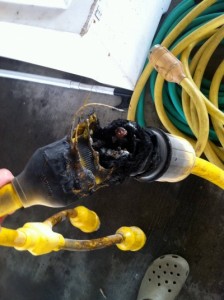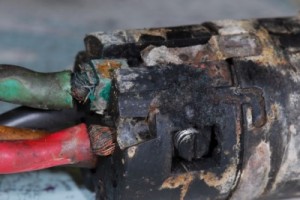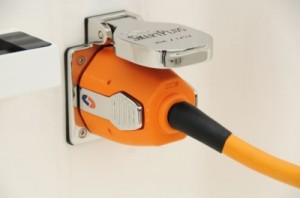Steve, I have admired your work for several years in PassageMaker and Professional Boat Builder magazines. My neighbor’s shore power cord caught fire. The 50-amp shore breaker never tripped. It had to be manually tripped to stop the arcing. My city marina staff says there is nothing wrong with the breaker. It is obvious there must have been some serious flaw in the shore power cord. But my question is, does this take more than 50 amps to cause this type of damage? As As with most cases like this there is more to the story. The boat owner had this shore power cable going to a fitting on the stern of his Carver 455. It is a 50-amp 220-volt cord that then splits into two 50-amp 110-volt legs. On Monday, September 5, we had some violent weather and the shore power splitter ends were pulled from the boat leaving the plastic retainer rings in place. The two ends of the Y are now hanging in the water, submerged about 6″. Another neighbor, sees this the next morning and notifies marina staff. Staff then comes to the boat and pulls the Y ends out of the seawater and turns off the breaker. They place the cord ends on the swim platform and call the owner and tell him what has happened. The boat owner is a handy guy. But either he just didn’t understand what the staff told him or he just made an error. His corrective action was to renew the plug on the main power cord that feeds the Y, cutting back about a foot. He hooks it up again and everything works and he leaves the boat with air-conditioners running. Five days later we have the fire that you see in the picture. I was awakened just before sunrise to the shouts of my neighbors. (We have several live aboards on our dock) There was popping and and a loud bang. A flash of light came through our curtains and illuminated the inside of our boat. By the time I came out of my boat the fire was out. My neighbors said they had to manually trip the breaker to stop the arcing and then they used hand held fire extinguishers to put out the flames. I thought that part of a circuit breaker’s purpose was not only to protect the component at the end of a circuit, but also to protect the wire that feeds that component. Because as the amperage goes up, heat goes up, the insulating jacket can melt and then the conductors can come together as they did in this case. We are lucky this failure occurred in a place where nothing flammable was near by. It was suspended in air between the boat and the dock. By my left foot in the image, you can see the two boat ends of the Y that were in salt water with the power on. Marina staff took the position that the boat owner caused the fire by his actions only. My question was, should the 50-amp circuit breaker have tripped automatically during this incident? Thank you, Hugh Steve D’Antonio replies: Hugh, With a few exceptions (motor loads being one), the primary purpose of an over current protection device, a fuse or circuit breaker, is to protect the wire from being overloaded. In this case the high resistance fault had 50 amps (x2) available to generate this heat before the breaker’s threshold was exceeded. Remember, a short is low resistance, heat is generated when there is high resistance. In short, breakers can’t be relied on to prevent resistance generated heat. It’s one of the reasons why, statistically, most boat fires start in the shore power system. Among the most common causes of shore cord overheating and fires, (and likely the cause of the overheating in this case) is use after immersion in seawater. If a cord end gets dunked, it should be washed out immediately with fresh water and then disassembled, inspected and cleaned before it’s used. It’s a common misunderstanding that breakers will trip in the event of a cord or cord end overheat. Typically, this is only the case if a low resistance short develops like if the cord is pinched in the dock and the hot leg makes direct contact with the ground, which is rare, for instance. In short, pardon the pun, the breaker will only trip if the load exceeds its rating, 50 (x2 for a 240 volt service) amps. The heat generated at the cord apparently did not exceed this limit and that’s not surprising. A 50-amp 240-volt cord set can provide cumulatively, 100 amps of energy (50 amps on each 120 leg). Thought of another way, that’s 12,000 watts. By comparison, a high output hair dryer is about between 500 and 1200 watts. The shore power supply will continue to provide this energy, with its heat generating capacity, as long as it does not exceed the primary breaker’s capacity. Think of it this way, if you powered several industrial heat guns from the same shore cord and aimed them at the cord, the result would have been the same. The cord would ultimately overheat and catch fire while continuing to supply the power to the heat guns, until or unless a short developed. Shore cord fires are not uncommon, it’s why the SmartPlug system It’s possible the thunderstorms had nothing to do with this fire other than perhaps the waves they generated pulling the cord and depositing its ends in the water. Rather, it’s likely that the dunking created salt deposits and corrosion in the cord that ultimately led to high resistance, which in turn created heat generation. Operating high ampere gear like HVAC equipment exacerbated or accelerated the heat generation caused by the resistance. I still would strongly recommend that the dock breaker be inspected and tested ot ensure it will trip at its rated amperage and with the correct delay. Sincerely, Steve D’Antonio Sign up for Steve’s Marine Systems Excellence blog at: https://www.stevedmarineconsulting.com/blog/ For more information on the services provided by Steve D’Antonio Marine Consulting, Inc. please e mail Steve at info@stevedmarineconsulting.com or call 804-776-0981
|






